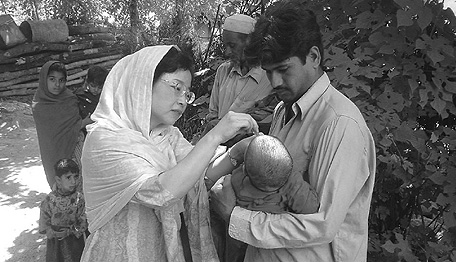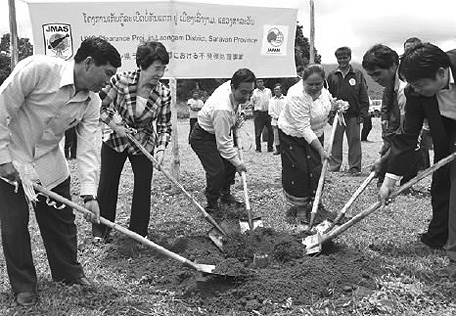Japan's Official Development Assistance White Paper 2011
Section 3 Increasingly Important New Actors in Development
The development needs of developing countries are considerably large and diverse. ODA and other governmental assistance alone are insufficient to respond to those needs. It is therefore necessary to encourage the participation of NGOs, private businesses, private foundations and other new actors in development, and mobilize those "people," "funds," and "knowledge," etc. For example, the observation that 60% to 70% of the funds flowing into developing countries are from the private sector also indicates that the role of non-governmental players in the development of developing countries is becoming significant.
Encouraging the activities of such new actors in development makes it possible to move ahead with effective and efficient development. To accomplish this, it is important to utilize ODA to remove barriers to the activities of new actors, and establish a link between ODA assistance and the activities of the new actors, and to build complementary relationships. It is effective to build a mutually beneficial relationship with other actors, making it possible to share governmental aid policy that promotes strategizing through the program approach (See the figure on page 39), etc., and exchange useful knowledge and experience in the field of development. While strengthening dialogue with a variety of actors on the one hand, the Japanese Government is also proactively advancing those new partnerships through the formation of concrete collaborative projects, etc.
For example, Japan is using ODA loans and partnering with the Bill & Melinda Gates Foundation in an innovative manner to support the eradication of polio in Pakistan. This project utilizes ODA loan to finance the costs of vaccines and a vaccination campaign to eradicate polio in Pakistan. Unlike ordinary loans, the Bill & Melinda Gates Foundation will repay the loan debt in place of the Pakistani Government, on the condition that the Government achieves certain results. Japan anticipates that the knowledge that Japan has accumulated over many years of support for efforts to eradicate polio in Pakistan, as well as funds from ODA loans, will prime the pump, making it possible to obtain new funds from the Bill & Melinda Gates Foundation for Pakistan, further accelerating the efforts to eradicate polio, an international challenge. (See "Partnering with Private-sector Funding" on the next page.)

Since 1996, Japan has utilized grant aid to provide the funds necessary to obtain polio vaccines and conduct immunizations, with the aim of supporting the eradication of polio in Pakistan. Here, a Japanese expert in measures against infectious diseases administers an oral vaccine to a child. (Photo: JICA)
As part of Japan's partnership with NGOs, the Government of Japan, an NGO and a private business are working together to reduce poverty in a rural area in Laos. As part of this effort, while on the one hand using Grant Aid for Japanese NGO Projects to enable Japan Mine Action Service (JMAS), a specified non-profit corporation to search for and remove unexploded ordnance, Tsumura & Co. is cultivating herbal medicine on the farmland that has been cleared of the unexploded ordnance. These efforts are expected to contribute to ensuring the security of the farmers, reducing poverty, and enabling the economic development of the region.
In addition, Japan is also strengthening efforts to encourage the participation of potential actors in development. Japan implements two types of preparatory survey based on proposals from the private sector, to encourage the participation of private organizations, etc., that have superior technologies, knowledge, and experiences, and that have an interest in overseas operations. During the preparatory survey related to formation of a public-private partnership (PPP)* infrastructure project, in addition to addressing input from private businesses at an early stage of formulation of the infrastructure project and responding to development needs that government is unable to assess fully, Japan considers the optimal division of roles between the public and private sectors, and put forward proposals to the governments of developing countries. In 2011, 8 projects, including projects in Indonesia and Vietnam, were adopted, which anticipate support from the governments of partner countries to the public sector, through ODA, including loans. Promoting development of the infrastructure through PPP is desired.
Further, BOP business* (Note 2) has recently been receiving attention as a new method of solving problems in developing countries. In preparatory survey to encourage partnerships with private-sector players that are aiming for participation in such BOP business, in addition to providing backup for the participation of Japanese companies and NGOs, etc., in BOP business areas in developing countries, Japan provides support for ODA partnerships with the private sector in BOP business, by assisting in the formulation of BOP business models of corporations (private businesses, NGOs, etc.) that have submitted proposals, and by requesting proposals regarding partnerships with ODA.
In addition, in June 2011, the Ministry of Foreign Affairs launched the MDGs Public-Private Partnership Network to promote public-private partnerships geared toward achievement of the Millennium Development Goals (MDGs). The Network issues information that is required by private businesses to contribute to meeting the development needs of developing countries and achieving the MDGs, and to provide support for local development in developing countries.
The areas of development are extremely broad, and the new actors in development are varied and diverse. To attempt new partnerships with players that have technology and knowledge in each area, and address development problems that cannot be handled with ODA alone, Japan will work proactively to build new cooperative relationships for development in the future as well. In addition, not only the providers of assistance, but the governments of developing countries that are the major receivers of ODA as well are increasing their interest in utilizing funds and other resources from private businesses and other sources outside the public sector for development. It will be necessary to involve the governments of developing countries in the cooperative relationships with new players in development, to achieve further progress in development.

The opening ceremony of a collaborative ODA project among Japanese government, private business (Tsumura), and NGO (JMAS) to remove unexploded ordnance in Laos
Terminology
*PPP (public-private partnership)
A new method of cooperation between the public and private sectors, in which governmental and private organizations collaborate in the undertaking of a project. Input from private businesses is incorporated in the formation of the project, and the basic infrastructure is prepared with ODA, with investment, operation, and maintenance management conducted by the private sector. In this manner, roles are divided between the public and private sectors, with the technologies, knowledge, experiences, and funds of the private sector used in an effort to implement activities that are more efficient and effective. (Examples of preparatory survey: Water and sewer systems, airport construction, motorways, railways, etc.)
*BOP business
Refers to the bottom level of the income pyramid for the overall population. Although it is poorest segment, it is said to consist of approximately 70% of the world's population, about 4 billion people, and is attracting attention as a market with the potential for growth. It is new business that targets the low-income level as consumers, producers, and sellers, and that is expected to be helpful in providing sustainable solutions to a variety of local societal problems. (Example: Detergent, shampoo, and other hygiene goods, water purifiers, nutritional food, solar power panels, mosquito netting soaked in insecticides, etc.)
*Low-income bracket: The income bracket with an annual income per capita of $3,000 or less in purchasing power parity. Purchasing power parity is determined by removing differences between price levels to make purchasing power between different currencies equivalent.
Notes:
(2) BOP: Base of the Pyramid
